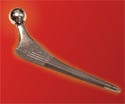Programmed Peptides Help Drugs Cling to Devices
Wireless data collected directly from patients during normal physical activities could enable the development of better knee implants
September 3, 2008
Originally Published MPMN September 2008
NEED TO KNOW
Programmed Peptides Help Drugs Cling to Devices
|
Affinergy's interfacial biomaterials help drugs cling to the surface of medical devices, such as this hip implant, without altering their surfaces. |
Biologically linking molecules while at Duke University (Durham, NC; www.duke.edu) led the founders of Affinergy Inc. (Durham, NC; www.affinergy.com) to develop what the company calls interfacial biomaterials (IFBMs). This peptide technology helps drugs and biologics cling to medical devices without altering their surfaces, and could potentially reduce health complications.
“Peptides are nanoscale coatings which do not appreciably alter the surface of the medical device,” explains Affinergy CEO Peyton Anderson. “For example, stainless steel will still act like stainless steel with our coatings even though a drug has been added. We can tether the biologic to a surface but not inactivate or change the therapeutic effect of the biologic.” The peptides bind to almost all traditional device materials, and the company is expanding the number of therapeutics that the IFBMs can bind to device surfaces.
The company likens the technology to double-sided tape; each side can be customized to the active molecule or surface. Dosage and delivery of the drugs are also customizable. Because of this capability, IFBMs can be used for site-specific biological delivery. “This avoids systemic delivery of drugs and reduces the amount of drugs that might be placed at a site by the device,” Anderson says.
In addition to binding small-molecule drugs like antimicrobial agents, analgesics, and steroids to medical devices, the company also is exploring surgical applications for the IFBMs, such as protein delivery from scaffolds. “We can control the dose and release of growth factors and other proteins when used in surgical procedures,” Anderson says. “This is important because the recombinant proteins are potent, expensive, and need to be targeted.”
The peptide coatings also have demonstrated the ability to accelerate the natural healing process and to preferentially bind cell populations to a surface. “We think of this as kick-starting the natural biological processes,” Anderson says. Unlike traditional polymer coatings that may create inflammatory responses, the peptide coatings can naturally resorb into safe by-products, he adds.
Unlike polymer coatings, which must be applied to devices prior to going to market, IFBMs have the potential to be applied to devices immediately prior to implantation, according to Anderson. The company is compiling a menu of possible coatings for different medical devices as well as drug and biologic delivery for point-of-care applications.
Copyright ©2008 Medical Product Manufacturing News
You May Also Like



